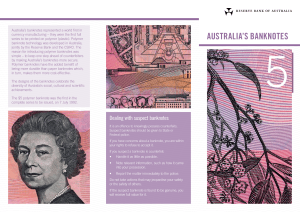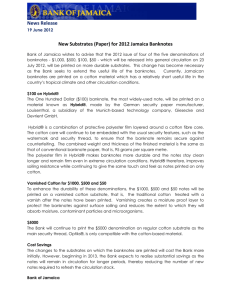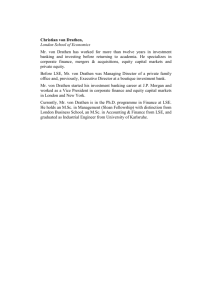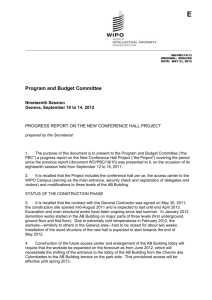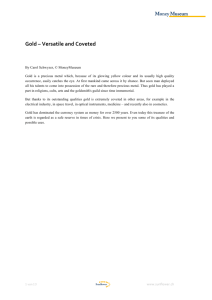The Most Appealing Banknotes of Switzerland
advertisement
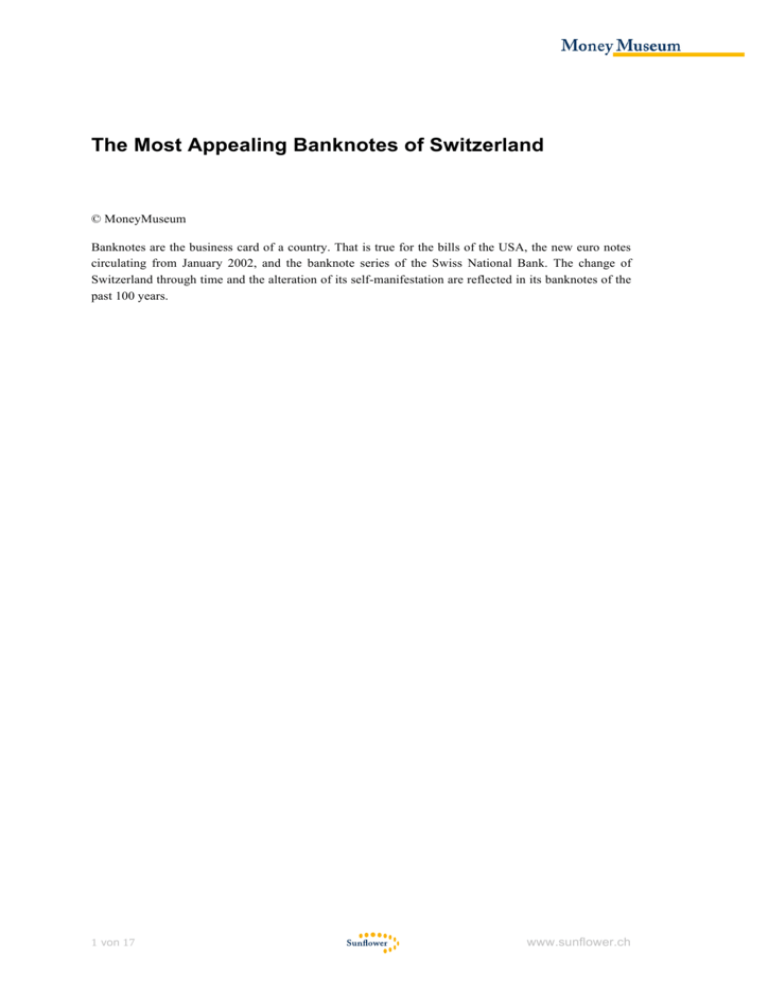
The Most Appealing Banknotes of Switzerland © MoneyMuseum Banknotes are the business card of a country. That is true for the bills of the USA, the new euro notes circulating from January 2002, and the banknote series of the Swiss National Bank. The change of Switzerland through time and the alteration of its self-manifestation are reflected in its banknotes of the past 100 years. 1 von 17 www.sunflower.ch 5 écus de 5 francs of the Cantonal Bank of Lausanne from 1847 In 1847, banknotes resembled mere bank receipts. The designs were not yet an expression of a united and concious nation. This would change in the course of the following decades, however ... 2 von 17 www.sunflower.ch 100 francs of the 2nd banknote series The Swiss National Bank set up a five-man commission for the preparation of its first own banknote series, actually the second series. This comittee, representing the different parts of the country, commissioned two men from the fine arts to design the new notes: Ferdinand Hodler, the painter of the popular, heroic "Marignano" painting, and Eugène Burnand, a master from Vaud, a canton in the French speaking west of Switzerland. Their depictions of rural and industrial life – reaper, foundry, embroiderer and woodcutter – were put into circulation between 1911 and 1914. The obverse of the 100-franc note designed by Ferdinand Hodler shows a woman's head in a medallion. 3 von 17 www.sunflower.ch 100 francs of the 2nd banknote series The reverse of Hodler's 100-franc note shows a reaper as a symbol of rural Switzerland. 4 von 17 www.sunflower.ch 20 francs of the 2nd banknote series The imminent outbreak of World War I led to the attempt to create a national Swiss identity. Hence, banknotes became ideal means for national propaganda. In July 1914, the 20-franc note of the second banknote series depicting "Vreneli," a symbol for bucolic Switzerland, was put into circulation. It was one of the few notes issued by the National Bank between the years of 1911 and 1942. The bill was also issued for economical reasons: the National Bank was afraid that the 20-franc gold coin would be hoarded during the war; the new note was meant as fallback for these coins. 5 von 17 www.sunflower.ch 5 francs of the 2nd banknote series In August 1914 followed the issue of a 5-franc bill showing the Swiss national hero par excellence: Wilhelm Tell. 6 von 17 www.sunflower.ch 1000 francs of the 4th banknote series Even a great name does not protect against great failure. The proof: the notes for the fourth banknote series predominantly designed by the Lucern artist Hans Erni. For unknown reasons, the bills depicting the rise of an industrialized nation never came into circulation. Yet even so, the fourth series created in 1938 was an important milestone: it represented the attempt of the National Bank to return to series of banknotes after having issued individual notes for decades. 7 von 17 www.sunflower.ch 1000 francs of the 5th banknote series It took almost five decades until the National Bank issued a new series of notes after the HodlerBurnand series. After World War II, the bank launched a contest for its fifth banknote series. It came into circulation in 1956 and 1957. This series was the first to be designed by graphic artists instead of painters. The motifs for the high denominations came from Pierre Gauchat and were quite new: they depicted allegories of fertility, motherhood, compassion and – maybe irritating at those times – death, as this note shows. Characteristic especially for the high values was also the huge size of the notes. 8 von 17 www.sunflower.ch 500 francs of the 5th banknote series This note from Pierre Gauchat illustrates the fountain of youth. It symbolizes the remarkable ability of men to draw hope even after the greatest catastrophes – the bills of the fifth series were issued only a few years after the Second World War had ended. 9 von 17 www.sunflower.ch 100 francs of the 5th banknote series The note with the motif of Saint Martin as symbol of helpfulness is for many the most impressive of all Swiss banknotes. It was also designed by Pierre Gauchat and belongs thus to the fifth series, circulating from 1956 to 1980. 10 von 17 www.sunflower.ch 50 francs of the 5th banknote series This banknote of Pierre Gauchat shows a bucolic idyll with the title "Apple Harvest." The design is a symbol for the fruitfulness of Switzerland – and of its inhabitants. 11 von 17 www.sunflower.ch 20 francs of the 5th banknote series The 10- and 20-franc notes of the fifth banknote series, in circulation until 1980, were designed by Hermann Eidenbenz. They feature two famous Swiss men, whose symbolism does not equal the patriotic symbolism of a Wilhelm Tell anymore, but nevertheless represented a cosmopolitan and solidly united Switzerland. This note illustrates the social activist Henri Dunant (*1828, †1910), the founder of the Red Cross. 12 von 17 www.sunflower.ch 10 francs of the 5th banknote series As the other representative of a cosmopolitan Switzerland, the writer Gottfried Keller (*1819, †1890) was chosen. 13 von 17 www.sunflower.ch Swiss Nationalbank, 500 francs of the 6th banknote series In the 1970s, the National Bank reconsidered its politics regarding the design of its bills once again, and launched a call for drafts with the following specifications: the obverse of the six new bills with values between 10 and 1000 francs was to depict Swiss scientists, while the reverse had to show an excerpt from their respective works. In the end, the bills of the sixth series were created by the graphic artists Ernst and Ursula Hiestand from Zurich. They were put into circulation between 1976 and 1979. 14 von 17 www.sunflower.ch 1000 francs of the 8th banknote series In 1989, a competition was held to find an artist for the creation of a new series of banknotes. Despite the fact that the graphic designer Jörg Zintzmeyer from Zurich only became third in the competition, the National Bank commissioned him with the drawings for the new bills. It is the eighth series of Swiss banknotes altogether. Its notes for the first time were issued between 1995 and 1998 and are still circulating. They depict six selected Swiss personalities whose achievements had gained international regard. This bill shows the art historian Jacob Burckhardt (*1818, †1897). 15 von 17 www.sunflower.ch 200 francs of the 8th banknote series The banknotes of Jörg Zintzmeyer could be put under the motto, "Where Money and Art Meet." The current Swiss banknotes are handier than the old ones, and regarding security, they are almost revolutionary: at least nine different printing tricks have been used to thwart the skills of the counterfeiters and the steadily improving copying technology. 16 von 17 www.sunflower.ch 100 francs of the 8th banknote series The bill of 100 francs from the latest series of Swiss banknotes depicts the artist Alberto Giacometti (*1901, †1966) on the obverse, while the reverse shows some of his well-known surrealistic plastics. 17 von 17 www.sunflower.ch

